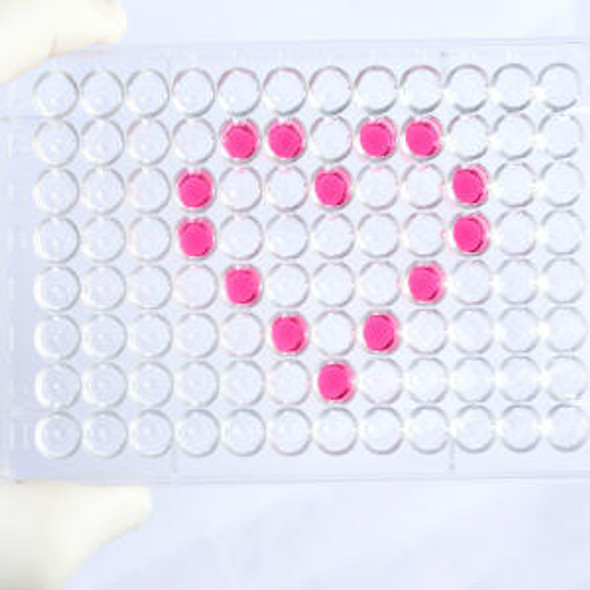Human LBP Recombinant Protein (RPPB3850)
- SKU:
- RPPB3850
- Product type:
- Recombinant Protein
- Size:
- 10ug
- Species:
- Human
- Target:
- LBP
- Synonyms:
- Lipopolysaccharide-binding protein
- LBP
- MGC22233
- Ly88
- Source:
- HEK293 Cells
- Uniprot:
- P18428
Description
| Product Name: | Human LBP Recombinant Protein |
| Product Code: | RPPB3850 |
| Size: | 10µg |
| Species: | Human |
| Target: | LBP |
| Synonyms: | Lipopolysaccharide-binding protein, LBP, MGC22233, Ly88. |
| Source: | HEK293 Cells |
| Physical Appearance: | Filtered White lyophilized (freeze-dried) powder. |
| Formulation: | LBP filtered (0.4 µm) and lyophilized from 0.5mg/ml solution in PBS, pH7.5 and 5% (w/v) Threalose. |
| Solubility: | It is recommended to add deionized water to prepare a working stock solution of approximately 0.5mg/ml and let the lyophilized pellet dissolve completely. |
| Stability: | Store lyophilized protein at -20°C. Aliquot the product after reconstitution to avoid repeated freezing/thawing cycles. Reconstituted protein can be stored at 4°C for a limited period of time; it does not show any change after two weeks at 4°C. |
| Purity: | Greater than 95.0% as determined by SDS-PAGE. |
| Amino Acid Sequence: | ANPGLVARIT DKGLQYAAQE GLLALQSELL RITLPDFTGD LRIPHVGRGR YEFHSLNIHS CELLHSALRP VPGQGLSLSI SDSSIRVQGR WKVRKSFFKL QGSFDVSVKG ISISVNLLLG SESSGRPTVT ASSCSSDIAD VEVDMSGDLG WLLNLFHNQI ESKFQKVLES RICEMIQKSV SSDLQPYLQT LPVTTEIDSF ADIDYSLVEA PRATAQMLEV MFKGEIFHRN HRSPVTLLAA VMSLPEEHNK MVYFAISDYV FNTASLVYHE EGYLNFSITD DMIPPDSNIR LTTKSFRPFV PRLARLYPNM NLELQGSVPS APLLNFSPGN LSVDPYMEID AFVLLPSSSK EPVFRLSVAT NVSATLTFNT SKITGFLKPG KVKVELKESK VGLFNAELLE ALLNYYILNT FYPKFNDKLA EGFPLPLLKR VQLYDLGLQI HKDFLFLGAN VQYMRVHHHH HH |
Lipopolysaccharides (LPS) are a type of glycolipids on the outer cell wall of Gram-negative bacteria. Lipopolysaccharide binding protein (aka LBP) is a plasma protein which facilitates the diffusion of bacterial LPS (endotoxin). LBP is involved in the acute-phase immunologic response to gram-negative bacterial infections. In cooperation with bactericidal permeability-increasing protein (BPI), LBP binds LPS and interacts with the CD14 receptor, most likely playing a role in regulating LPS-dependent monocyte responses. LBP belongs to a family of structurally and functionally related proteins, including BPI, plasma cholesteryl ester transfer protein (CETP), and phospholipid transfer protein (PLTP). The LBP gene is found on chromosome 20, directly downstream of the BPI gene. LBP catalyzes the transfer of LPS monomers from LPS aggregates to HDL particles, to phospholipid bilayers, and to a binding site on soluble CD14 (sCD14). sCD14 is capable of speeding up the transfer by receiving an LPS monomer from an LPS aggregate, and then yielding it to an HDL particle, therefore acting as a soluble "shuttle" for an insoluble lipid.
LBP Human Recombinant is a single, glycosylated polypeptide chain containing 462 amino acids (26-481a.a) and having a molecular mass of 51.7kDa (calculated). LBP is fused to a 6 a.a His tag at C-terminal.
| UniProt Protein Function: | LBP: Binds to the lipid A moiety of bacterial lipopolysaccharides (LPS), a glycolipid present in the outer membrane of all Gram-negative bacteria. The LBP/LPS complex seems to interact with the CD14 receptor. Belongs to the BPI/LBP/Plunc superfamily. BPI/LBP family. |
| UniProt Protein Details: | Protein type:Secreted, signal peptide; Secreted Chromosomal Location of Human Ortholog: 20q11.23 Cellular Component: extracellular space; cell surface; extracellular region Molecular Function:protein binding; lipopolysaccharide binding; receptor binding Biological Process: positive regulation of tumor necrosis factor biosynthetic process; detection of molecule of bacterial origin; positive regulation of toll-like receptor 4 signaling pathway; positive regulation of interleukin-6 production; response to lipopolysaccharide; negative regulation of tumor necrosis factor production; positive regulation of tumor necrosis factor production; defense response to Gram-negative bacterium; leukocyte chemotaxis during inflammatory response; positive regulation of chemokine production; positive regulation of interleukin-8 production; lipopolysaccharide transport; defense response to Gram-positive bacterium; macrophage activation during immune response; lipopolysaccharide-mediated signaling pathway; toll-like receptor signaling pathway; acute-phase response; innate immune response; cellular defense response; opsonization; toll-like receptor 4 signaling pathway; positive regulation of macrophage activation |
| NCBI Summary: | The protein encoded by this gene is involved in the acute-phase immunologic response to gram-negative bacterial infections. Gram-negative bacteria contain a glycolipid, lipopolysaccharide (LPS), on their outer cell wall. Together with bactericidal permeability-increasing protein (BPI), the encoded protein binds LPS and interacts with the CD14 receptor, probably playing a role in regulating LPS-dependent monocyte responses. Studies in mice suggest that the encoded protein is necessary for the rapid acute-phase response to LPS but not for the clearance of LPS from circulation. This protein is part of a family of structurally and functionally related proteins, including BPI, plasma cholesteryl ester transfer protein (CETP), and phospholipid transfer protein (PLTP). [provided by RefSeq, Apr 2012] |
| UniProt Code: | P18428 |
| NCBI GenInfo Identifier: | 116242615 |
| NCBI Gene ID: | 3929 |
| NCBI Accession: | P18428.3 |
| UniProt Secondary Accession: | P18428,O43438, Q92672, Q9H403, Q9UD66, B2R938, |
| UniProt Related Accession: | P18428 |
| Molecular Weight: | 53,384 Da |
| NCBI Full Name: | Lipopolysaccharide-binding protein |
| NCBI Synonym Full Names: | lipopolysaccharide binding protein |
| NCBI Official Symbol: | LBP |
| NCBI Official Synonym Symbols: | BPIFD2 |
| NCBI Protein Information: | lipopolysaccharide-binding protein; LPS-binding protein; BPI fold containing family D, member 2 |
| UniProt Protein Name: | Lipopolysaccharide-binding protein |
| Protein Family: | Lipopolysaccharide-binding protein |
| UniProt Gene Name: | LBP |
| UniProt Entry Name: | LBP_HUMAN |










